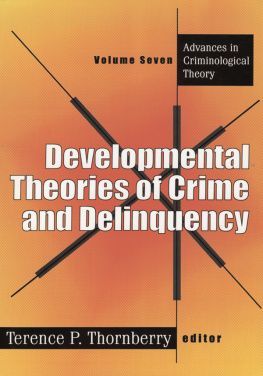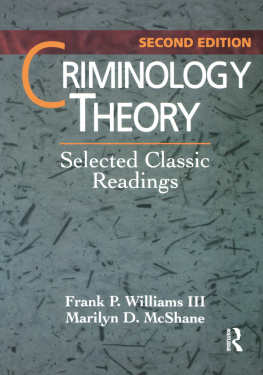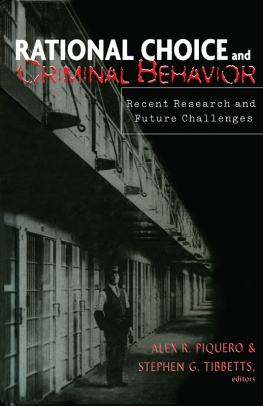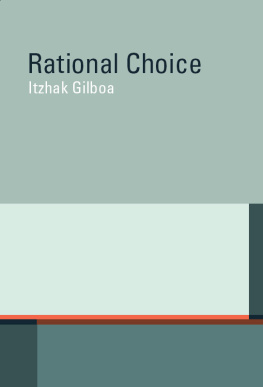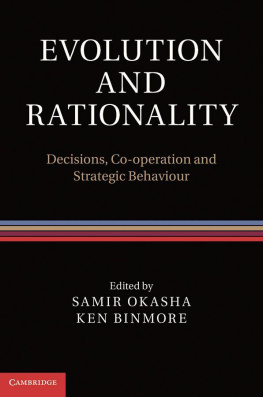Routine Activity and Rational Choice
Editors
Freda Adler
Rutgers University
William S. Laufer
University of Pennsylvania
Editorial Board
Advances in Criminological Theory
Robert Agnew
Emory University
Ko-Lin Chin
Rutgers University
Albert K. Cohen
University of Connecticut
Francis T. Cullen
University of Cincinnati
Simon Dinitz
Ohio State University
Delbert Elliott
University of Colorado
David Farrington
Cambridge University
James O. Finckenauer
Rutgers University
John Laub
University of Maryland
William S. Laufer
University of Pennsylvania
Joan McCord
Temple University
Terrie E. Moffit
University of Wisconsin-Madison
Gerhard O. W. Mueller
Rutgers University
Joan Petersillia
University of California-Irvine
Robert J. Sampson
University of Chicago
Kip Schlegel
Indiana University
Lawrence Sherman
University of Pennsylvania
David Weisburd
Herbrew University
Elmar Weitekamp
University of Tubingen
William Julius Wilson
Harvard University
Routine Activity and Rational Choice
Advances in Criminological Theory
Volume 5
Ronald V. Clarke and Marcus Felson , editors
First published 1993 by Transaction Publishers
Published 2017 by Routledge
2 Park Square, Milton Park, Abingdon, Oxon OX14 4RN
711 Third Avenue, New York, NY 10017, USA
Routledge is an imprint of the Taylor & Francis Group, an informa business
Copyright 1993 by Taylor & Francis
All rights reserved. No part of this book may be reprinted or reproduced or utilised in any form or by any electronic, mechanical, or other means, now known or hereafter invented, including photocopying and recording, or in any information storage or retrieval system, without permission in writing from the publishers.
Notice:
Product or corporate names may be trademarks or registered trademarks, and are used only for identification and explanation without intent to infringe.
ISSN: 0894-2366
ISBN 13: 978-0-7658-0831-8 (pbk)
In Memoriam
Franco Ferracuti
1927-1992
When the essays for this collection were being commissioned, one of the contributors, Pietro Marongiu, offered to convene a conference that would give contributors the opportunity to debate some of the broader issues surrounding the routine activity and rational choice approaches. These issues, such as the relationship between these new approaches and existing criminological theory, would not be directly addressed in many of the essays, but were still of considerable importance to all contributors. The meeting would also provide the occasion for the valuable, informal discussions that always take place when academics with similar interests meet together.
The conference was held in June 1992 in Chia Laguna, Sardinia, in conjunction with the Second National Congress of the Italian Society of Forensic Psychiatry. It proved to be a most pleasant occasion, more than amply fulfilling its original goals, and enriched by the contributions of the psychiatrists attending the sessions. The conference also helped the production of this volume in some tangible ways: It set a natural deadline for the completion of essays and assisted us, as editors, in identifying topics needing to be addressed in our Introduction.
We are therefore most grateful to Professor Marongiu for arranging the meeting, to Professor Nereide Rudas, President of the Italian Society of Forensic Psychiatry, who facilitated the conference by consenting for it to be held in tandem with the Society's own meeting, and to The Honorable Giorgio Oppi, Assessore all'Igiene e Sanit della Regione Autonoma della Sardegna, without whose support and encouragement the meeting would not have been possible.
It had always seemed appropriate that a meeting on "Advances in Criminological Theory" should be held in Italy, the cradle of criminology. We therefore had no hesitation in agreeing when Freda Adler, the series editor, suggested that this volume be dedicated to the memory of Franco Ferracuti who died in March 1992. Franco Ferracuti was not only the author (with Marvin Wolfgang) of The Subculture of Violence , a theoretical treatise known to every academic criminologist, but was also the most distinguished Italian criminologist of his generation.
R.V.C
M.F.
Ronald V. Clarke and Marcus Felson
It might seem strange that proponents of two distinct theoretical approaches should join forces in a single volume less than fifteen years after the appearance of what might be considered competing paradigms. This theoretical cooperation may be all the more surprising when both proponents feel confident in the viability and vitality of their respective approaches. In fact, the routine activity and rational choice approaches, though differing in scope and purpose, are compatible and, indeed, mutually supportive. This volume provides the opportunity to acknowledge this compatibility and to give shape to the informal collaboration that has existed for some years among the contributors and editors. It has also provided an opportunity to consider the relationship between routine activity and rational choice and some other related theoretical and preventive approaches. Lastly, it has encouraged a fuller treatment of the relationship between these new approaches to crime and the traditional theories that currently dominate the textbooks. These topics are discussed below, but first we turn to brief descriptions of the routine activity and rational choice approaches.
The Routine Activity Approach
The routine activity approach (Cohen and Felson 1979) began by considering only direct-contact predatory violations. These required that at least one offender take or damage the property of at least one other person. This excluded any interest in such criminal violations as fights between equally "guilty" parties or illegal drug sales between consenting persons. Note also the use of the word violations rather than the word crime . The latter word is ambiguous about whether it refers to any single event or a general category, whereas the word violation directly refers to an event. To emphasize this point, the original paper continuously repeated the words incident and event, also using the modifier direct-contact to underline the concern for direct physical contact between offender and target of crime. Similarly, the word victim was avoided, since this person need not be immediately present, whereas the routine activity approach insisted upon discussing who and what was present during a criminal incident. Persons were treated virtually as objects and their motivations were scrupulously avoided as a topic of discussion, in stark contrast to the heavy motivational emphasis of virtually all contemporary criminology at that time. Even the word motivation was avoided, and the word inclination substituted so as to avoid reminding the reader that motivations might exist. Thus, at the outset the approach distinguished clearly between criminal inclinations and criminal events and made that distinction a centerpiece rather than a footnote. Moreover, it cast its lot unquestionably with events rather than inclinations. It did not deny the existence of criminal inclinations, but took these as given, virtually dismissing what was central to most contemporary criminology of the 1960s and 1970s.


